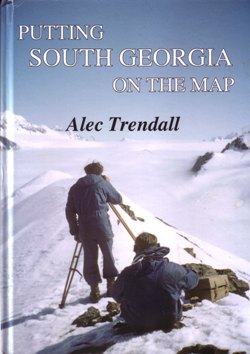
Putting South Georgia on the Map
Geoscientist 22.03 April 2012
The line “South Georgia rising out of the ocean, like a misplaced section of the Alps” epitomises this book, which it was intended should be written by Duncan Carse, who organised and led three private expeditions to South Georgia in the 1950s. On his death the task devolved on AlecTrendall. This is an important record, which otherwise might have been lost, of the island named by Cook, visited by Bellingshausen, and made famous by Shackleton’s epic boat journey and overland traverse.
The book commences with a historical introduction, leading on to a summary of Duncan Carse’s early life as an apprentice on Archibald Russell, Discovery II, RNVR service (WW2) and his ‘master plan’ to be a polar explorer and lead a trans-Antarctic Expedition. It covers the 1949 attempt to organise a small South Georgia expedition and its fruition (with RGS and SPRI support), leading to the 1951-52, 1953-54 and 1955-56 expeditions, with a primary object to map the entire island.
The next section is written by Walter Roots (pp38-66) and covers the 1951-2 expedition. It is emphasised that in such a little-known area, geological survey work had to be kept simple: recording information of rock composition and structure, in as much detail from as many localities as possible. The basic tools were hand-lens, compass, clinometer, notebook, camera, geological hammer. Collecting samples for laboratory study was important, especially fossils for dating. At the time, rock-dating meant superposition and biostratigraphy: radiometric methods were not yet available.
The second expedition (pp71-90) was bedevilled by Duncan Carse’s deterioration, due to the failure of his marriage and worries about the Trans-Antarctic Expedition, as well as his quarrel with Gordon Smillie. Keith Warbuton was ill and never contributed. But Alec, though still lame, performed much valuable geological observation - especially in the complicated developments at Wirik Bay. By the end of the second season they established that the island was largely composed of Mesozoic (Cretaceous) turbidites (greywackes); though there are also granitic rocks, gabbros, lavas and two sets of dykes cutting everything else in the south east. Trendall’s geological map contributed to the decision of the British Antarctic Survey to begin a detailed geological study of South Georgia in 1969.
The third expedition is described at second hand: the party completed the topographic survey of the island with no acrimony. Appendices cover ‘The men of the South Georgia Surveys’; sources; glossary; Shackleton’s route. This is a splendid, superbly illustrated, book and should be widely read.
Joe McCall
PUTTING SOUTH GEORGIA ON THE MAP
ALEC TRENDALL (WALTER ROOTS)
Published by the author, 2011. ISBN: 978-9870614-0-9 (hbk) 978-9870614-1-6 (pbk). 216 pp Price: Hbk A$50 in Australia (A$60 elsewhere). Pbk A$40 (A$50 elsewhere). Signed copies: A$80 in Australia (A$90 elsewhere).
www.alectrendall.com.au